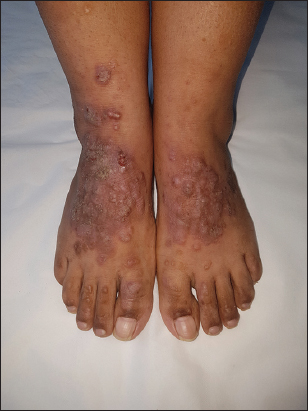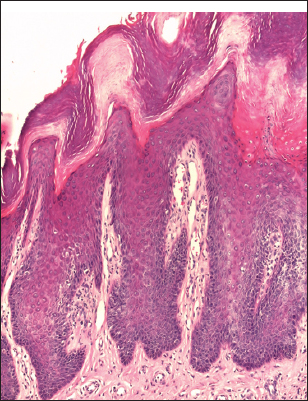|
Get Citation
|
|
|
Bazouti S, Zerrouki N, Dikhaye S, Zizi N. Acrokeratosis verruciformis of Hopf. Our Dermatol Online. 2019;10(1):93-93. |
|
|
Download citation file:
|
Acrokeratosis verruciformis of Hopf
Sabah Bazouti1, Nassiba Zerrouki1, Siham Dikhaye12, Nada Zizi12
1Department of Dermatology, Mohammed VI University Hospital of Oujda, Medical School of Oujda, Mohammed the First, University of Oujda, Oujda, Morocco, 2Epidemiology Laboratory of Research and Public Health, Oujda, Morocco
Corresponding author: Dr. Sabah Bazouti, E-mail: Sabah.bazouti@gmail.com
Submission: 16.06.2018; Acceptance: 29.07.2018
DOI: 10.7241/ourd.20191.27
A 30-year-old female presented with multiple nodules, grouped, hyperkeratotic, brownish and malodorous on his feet (Fig. 1), which had been present for more than 3 years. Histopathological examination showed classical feature of “church spires” appearance without dyskeratosis (Fig. 2). Acrokeratosis Verruciformis of Hopf is a rare autosomal dominant genodermatosis. It usually develops during early childhood affecting both sexes equally. Typically, the lesions are warty to convex, brownish to skin-colored papules on the dorsa of the hands and feet, forearms and legs. Histopathologically, the lesion shows considerable hyperkeratosis, acanthosis, and papillomatosis, mimicking a “church spire”, and a thickened granular layer. It arises in early life, often at birth or infancy.
The only effective treatment of AKV is superficial ablation.
CONSENT
The examination of the patient was conducted according to the Declaration of Helsinki principles.
Notes
Source of Support: Nil
Conflict of Interest: None declared.


Comments are closed.